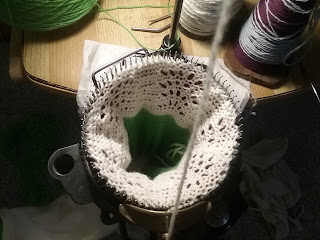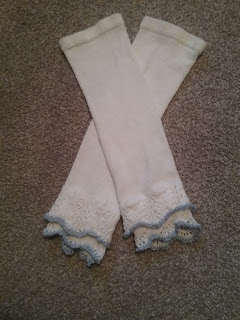Revisiting these 1855 knit undersleeves, which I have previously made all the component for (sleeve, ruffles), but never finished due to frustration with the instructions.
 |
| Warm Undersleeve. |
A few changes to make this project circular knitting machine compatible:
First, brioche stitch isn't happening. I can do a double knit by running two threads, or I can just plain knit it. I decided to make a plain tube this time, since it's my first attempt at doing this pattern on a machine, and also the dress I'm going to wear this with is a nice warm wool in the first place.
The frills, as written, have a bit of a problem: they include decreases (knit 2 together) with no corresponding increases. I tried it as written, and again with yarn-overs to balance out the knit-2-togethers, but only got a closely-set eyelet motif. Helpful fellow volunteer Cynthia identified the original pattern as "Old Shale" and recommended the following variation as producing something more like the illustration (especially if the frill is worked on thicker needles than the sleeve itself):
Row 1: Knit
Row 2: Purl
Row 3: Knit two together (3x), yarn over & knit 1 (6x), knit two together (3x). Repeat for the whole row
Row 4: Knit
[Per the original instructions, repeat the four rows 5 times (for 20 rows total) in white, then knit all four rows once in a colored yarn.]
If I make the fourth row a "purl", I can knit this in the round on the machine, though at the cost of the the ridged effect between repeats. For all the flaws of the illustrations, I think the stronger horizontal lines are meant to indicate this ridge.
The pattern is a 96 repeat, and the original calls for 90 stitches, but the largest cylinder I have is an 80, so I'll need to repeat the motif in row 3 four times, which will leave 8 stitches left over. I decided to solve this with a partial motif as follows:
1-2. Knit.
3. On the third, k2to 3x, then (yo k1) 6x, k2to 3x; repeat this 4 times, and for the last 8 needles k2to 3x, yo, k1, yo, k1, yo. [On the machine, this look like: starting at the 3 o'clock mark, move the stitch on the second needle to the first, then the stitches on needles 3 & 4 to needle 2, then the stitches on needle 5 & 6 to needle 3. Leaving needle 4 empty, move the stitch from needle 7 to needle 5, leave 6 empty and move the stitch from needle 8 to needle 7; needle 8 is also left empty and needle 9 keeps its stitch in place. Count to the end of the motif, and double up the stitches on needles 13-18 so that there are two stitches each on needles 16-18 (as at the beginning of the motif), while needles 13-15 are temporarily empty. Then move the stitch from needle 12 to needle 15; leave 14 empty; move the stitch from needle 11 to needle 13; leave 12 empty; move the stitch on 10 to 11, leaving 10 empty. Repeat for a total of 4 and half repeats around one circuit.]
4. Knit.
 |
| Frill on the machine (working the 5th fancy row) |
As previously noted, after the 3 plain rows of the header, this four-row figure is repeated 5 times in white, and
then once in color, then bound off. Of course, I was halfway through the
fourth piece when I realized that the 8 extra stitches could be divided
up between the motifs (2 extra plain stitches at the center of the sets
of doubles, for instance), which would be a bit more symmetrical than having an extra half-motif.
I set my machine to the loosest possible tension for working this frill, after knitting the sleeve itself on the tension setting one rotation higher/tighter. [I denote it "1L1" in my notes, because the dial reads "1", and it's at the lowest dial position that can read "1"].
For the main sleeve, I set my knitter to "1L2", knit 20, hung the hem, then knit 130 rows, then adjusted the tension down to the its very loosest setting ("1L1") and started on the frill.
 |
| Frill with waste yarn. It scallops and has eyelets, at least. |
 |
| Blocking the completed frills and sleeves. |
Off the machine, I bound the edges of each of the four frill edges, then whipped the separate frills onto the sleeves. I had intended to bind the edges before blocking each component flat, but holiday logistics meant I needed to complete the blocking before I had the chance to binding off more than one edge. I think this actually helped the scallops set better.
Whipping the active stitches on the frills (the topmost of those 3 plain rows) onto the sleeves was actually the worst part. I could not keep a consistent horizontal line across the sleeve (counting was complicated by the frill covering that part of the sleeve, the lace motif itself made both frill and sleeve pucker into scallops, and attempting to eyeball the frill placement sent it rapidly veering onto diagonals). In the end, I ran a thread of waste yarn along a ruler in an approximately flat line, and stitched over it. For one frill, I removed the waste yarn as I bound the open edge, for the other I transferred the live stitches onto a circular hand-knitting needle to hold them; the waste yarn ended up being marginally easier to handle.
Et voila:
 |
| At long last, the finished sleeves. |
No comments:
Post a Comment
Thanks for commenting!